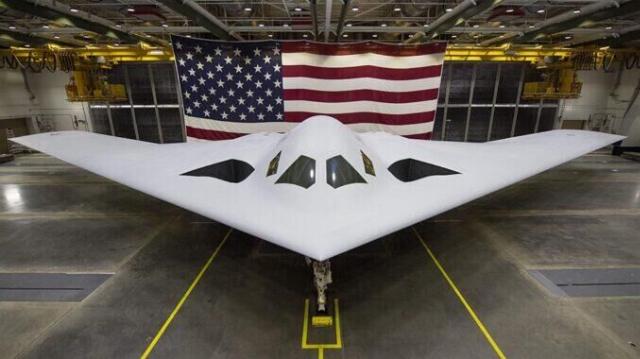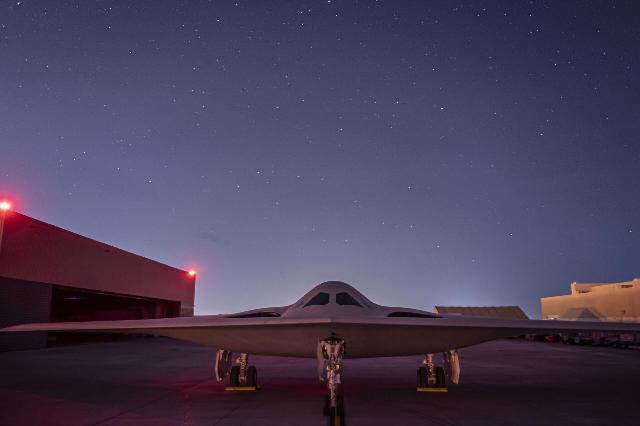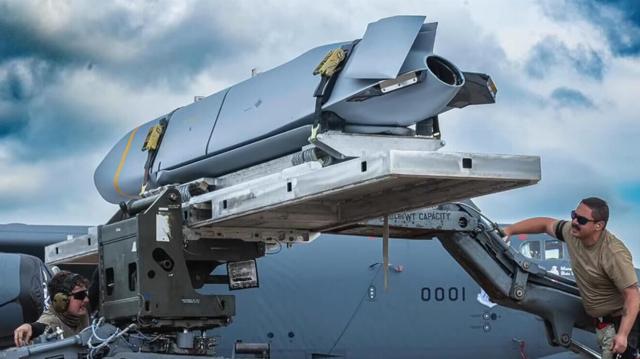MOSCOW, Nov 18 — RIA Novosti, Andrey Kotz. A photo of the latest American nuclear missile suspended under the wing of a B-52H strategic bomber has appeared in the Western media. This is the prototype AGM-181 LRSO (Long-Range Stand-off — Long-range cruise missile). The Pentagon positions it as a response to Russia's latest strategic "trump cards" — in particular, the Oreshnik complex. What is known about the LRSO is in the RIA Novosti article.
Up to 150 kilotons
The first contract for the advanced AGM-181 cruise missile for the US strategic aviation was planned to be signed back in 2015. However, at that time, there were many opponents in Congress and the Pentagon who argued that these weapons were too expensive and ineffective compared to other means of delivering a nuclear charge. Nevertheless, in 2017, the Defense Ministry ordered two variants of the cruise missile from Raytheon and Lockheed Martin.

The AGM-181 LRSO missile
Image source: © Public domain/U.S. Air Force
In early July 2021, Raytheon was chosen as the main and only developer and allocated two billion dollars for design, flight testing and mass production preparation. The promising system is planned to be put into service before 2027, and mass deliveries to the troops in the 2030s. The Pentagon expects to receive at least a thousand AGM-181s for the B-52 strategic bombers and the latest B-21.
Little is known about the tactical and technical characteristics of the rocket. American generals have repeatedly stated that strategic aviation should have weapons capable of overcoming a modern layered air defense system. This means that the AGM-181 uses composite materials and other elements of the so-called stealth technology. According to experts, the flight range is two and a half to three thousand kilometers, the speed is 800-850 kilometers per hour.

The AGM-181 LRSO missile
Image source: © Public domain/U.S. Air Force
The Pentagon wanted two versions of the AGM-181 — in nuclear and conventional equipment. However, the conventional modification was eventually abandoned, as it would essentially duplicate the AGM-158 JASSM in service. The nuclear warhead for the LRSO has already been selected — it is a well-developed industry W80 of the latest modification mod 4. It was reported that the first W80-4 will be assembled by September 2025. The charge capacity ranges from five to 150 kilotons, which will make it possible to destroy both single targets (for example, missile silos) and areal targets equally effectively.
Washington has repeatedly stated that the United States must modernize the nuclear triad in order to keep up with Russia. In particular, the AGM-181 missile is positioned as the answer to the "Hazel Tree". However, these are unequal systems. The Russian complex has a range of up to 5,500 kilometers and is equipped with a separable warhead with individual guidance warheads. The LRSO is more similar in characteristics to the Russian 250-kiloton X-102 cruise missile, which is armed with long-range Tu-160 missile carriers.
The long arm
The issue of modernizing the nuclear arsenal is far from an idle one for the United States. The LRSO is supposed to replace the AGM-86B cruise missiles developed almost half a century ago and adopted in 1981. As the US Air Force command admitted, over the years these weapons have become increasingly difficult to maintain due to the outdated element base. In addition, modern Russian and Chinese anti-aircraft systems are able to easily detect and shoot down relatively slow-moving AGM-86B.
However, at one time, this rocket was a formidable weapon. The AGM-86B flies about 2.5 thousand kilometers. The turbojet engine accelerates the ammunition to thousands of kilometers per hour. The wings and rudders are collapsible, released from the fuselage two seconds after launch. An inertial navigation system is responsible for movement in flight: an on-board digital computer (BCVM), an inertial platform and a barometric altimeter. The missile is quite accurate — the circular probable deviation from the target does not exceed 80 meters, which is not at all critical for a nuclear munition.
The AGM-86B is armed with B-52 strategic bombers. One aircraft carries up to 20 missiles: eight in the bomb bay and another dozen on pylons under the wings. However, the AGM-86B is not suitable for more modern B-1 and B-2 strategic missile carriers due to its too large dimensions. And this is another reason why the Pentagon decided to update the arsenal of "strategists".
The B-52 has been in service for more than half a century — since February 1955. Although the aircraft's service life has been extended until 2030, these machines are clearly outdated. Sooner or later they will be retired, and then the United States risks being left without air-launched nuclear cruise missiles.
The "golden" carrier
The main carriers of the LRSO will be the "invisible" B-21 Raider. New-generation strategic bombers have been developed since 2016 by the industrial giant Northrop Grumman. The first flight model for the Air Force began to be assembled in September 2019 and was first presented to the general public in December 2022 at the corporation's Palmdale facility. In September 2025, flight tests of the second prototype of the B-21 began, during which the integration of weapons and control systems is being worked out. There are also about a dozen bombers at various stages of assembly.

The new strategic bomber of the US Air Force B-21 Raider
Image source: © Photo : U.S. Air Force
The B-21 "Raider" is made according to the flying wing aerodynamic scheme and looks similar to its predecessor, the B-2. However, it is more compact: the wingspan is 45 meters against 52. Detailed tactical and flight characteristics of the bomber were not disclosed. However, it is known that the aircraft is subsonic, capable of reaching a maximum speed of 0.8 Mach. The vehicle can carry up to nine tons of weapons, from high—precision JASSM-ER cruise missiles with a range of up to a thousand kilometers to B-61 nuclear bombs in the latest versions.
The Pentagon intends to order up to 145 aircraft. However, experts say, the B-21 risks repeating the fate of the B-2, which is considered the most expensive production aircraft in aviation history. The price of one car, including research and development work, exceeded two billion dollars. The US Air Force received only 21 Spirits, although the program provided for the supply of more than 130 units.

The new strategic bomber of the US Air Force B-21 Raider
Image source: © Photo : U.S. Air Force
The Pentagon has not yet announced the approximate cost of the B-21 bomber. But, given the ever-growing appetites of the American "defense industry" and the general increase in costs for the development and creation of advanced weapons, Washington's bold plans for 145 vehicles will have to be seriously adjusted, as well as the number of LRSO cruise missiles intended for them.
French debut
In addition to the Americans, the French demonstrated a new means of nuclear destruction. The media published a photo of a Rafale fighter armed with an ASMPA-R missile. This is, in fact, an upgraded ASMP-A, adopted in 2009, and, in turn, is a development of ASMP (in service since 1986).
The ASMP-R is a cruise missile with a nuclear warhead with a capacity of up to 300 kilotons and a range of up to 500-600 kilometers. In the future, these weapons will form the basis of the aerial component of the French nuclear arsenal. The missile was put into service in 2024 and was used in the Operation Durandal nuclear forces exercises in May last year. Local media reported that the product's test debut was normal.
France is currently developing a next—generation rocket, the hypersonic ASN4G. It will carry the same warhead as the ASMP-R, will be able to hit a thousand kilometers and reach speeds of up to Mach six or seven. A modification of the carrier, the Rafale F5, is being created specifically for it. The new missile is expected to enter service by 2035. Meanwhile, Russia is already actively and successfully using an analog, the hypersonic Dagger, against targets in Ukraine.

